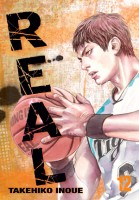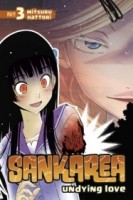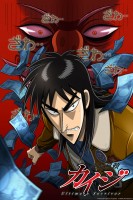My News and Reviews
To start things off, I would like to thank everyone who voted in the poll to pick my next monthly review project. I am very pleased to announce that over the next year I will have a series of reviews that focuses on yuri and lesbian comics and manga. A Year of Yuri took an early lead in the poll and earned just under half of the votes. I’m now in the process of determining exactly which comics I’ll be reviewing for this project. Nothing has been finalized yet, but ideally there will be a good variety of both old and new titles. I’d also like to thank those of you who took time to comment on the poll as well. I was sincerely interested in reviewing all of the choices; taking into consideration all of your input and suggestions, I’m currently working on other ways to review some of the manga outside of a monthly review project. I had fun with the poll, so thank you again for indulging me!
There was a mix of different posts at Experiments in Manga last week. Of particular note, the monthly manga giveaway—a Fairy Tail Feast—is currently in progress. I completely underestimated the popularity of Fairy Tail; I’ve never had so many people turn out for a giveaway before. Not even for Tezuka. There’s still time to enter for a chance to win volumes thirty, thirty-one, and thirty-two of Hiro Mashima’s Fairy Tail manga. And as a bonus the winner of the giveaway will also receive a copy of the anime movie Fairy Tail: Phoenix Priestess! November’s Bookshelf Overload was also posted last week as was my review for Ichiya Sazanami’s manga Black Bard. It’s a bit of a mess, but I still had a lot of fun reading it; I couldn’t resist the combination of music and magic.
Since last week was Thanksgiving here in the United States (my favorite holiday!) I was doing quite a bit of traveling. So, I probably missed out on a lot of the week’s manga news. But there are still a couple of links that I’d like to mention here: The most recent Speakeasy Podcast focused on Crunchyroll’s new manga project. And over at Manga Bookshelf proper, Melinda Beasi posted a Status Update & Station Identification which includes a shout-out to Experiments in Manga which joined the Manga Bookshelf family a few months ago. (She also described my mind as “deeply eloquent” which absolutely made my day. Hopefully I can continue to live up to her expectations!)
Quick Takes
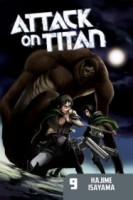 Attack on Titan, Volume 9 by Hajime Isayama. The mysteries keep piling up in Attack on Titan. It makes me wonder how long Isayama will be able to keep the series going without it collapsing under its own weight. The more ideas and plot twists he adds to the story, which can admittedly be very exciting, the less focused Attack on Titan becomes. I have no idea how much Isayama has thought through to the end or how much he is making up as he goes. It’s very possible that he could he write himself into some sort of absurd corner. That being said, I am hooked on the series and I really want to know what’s going on. This particular volume reveals more about some of the secondary characters, especially Sasha, Connie, Krista, and Ymir. It also provides the setup for what will be some very big plot reveals. The artwork in Attack on Titan continues to be incredibly uneven, which is unfortunate. There are a few brilliant panels and the titans are appropriately disconcerting, but the artwork remains one of the manga’s weakest points.
Attack on Titan, Volume 9 by Hajime Isayama. The mysteries keep piling up in Attack on Titan. It makes me wonder how long Isayama will be able to keep the series going without it collapsing under its own weight. The more ideas and plot twists he adds to the story, which can admittedly be very exciting, the less focused Attack on Titan becomes. I have no idea how much Isayama has thought through to the end or how much he is making up as he goes. It’s very possible that he could he write himself into some sort of absurd corner. That being said, I am hooked on the series and I really want to know what’s going on. This particular volume reveals more about some of the secondary characters, especially Sasha, Connie, Krista, and Ymir. It also provides the setup for what will be some very big plot reveals. The artwork in Attack on Titan continues to be incredibly uneven, which is unfortunate. There are a few brilliant panels and the titans are appropriately disconcerting, but the artwork remains one of the manga’s weakest points.
 From the New World, Volume 1 written by Yusuke Kishi and illustrated by Toru Oikawa. Honestly, I am more interested in reading Kishi’s original From the New World novel (and I’m still hoping that it will one day be licensed), but it’s the anime and manga adaptations that are currently available in English. After reading the first volume of the manga, I want to read the original novel more than ever. From the New World has a fantastically dark ambiance. I also have an established fondness for dystopias and tales of survival. Unfortunately, the level and intensity of fanservice in the manga feels out of place distracts from what could be an extremely intriguing premise. Saki’s clothing choices in particular are ridiculous and could hardly be described as functional. (Bizarrely enough, some of the outfits aren’t really all that attractive, either.) I’m not even going to try to explain Maria’s underwear. Still, all of the moments in between the nonsensical bath and sex scenes are legitimately engrossing. I do plan on continuing on with From the New World for at least a little longer.
From the New World, Volume 1 written by Yusuke Kishi and illustrated by Toru Oikawa. Honestly, I am more interested in reading Kishi’s original From the New World novel (and I’m still hoping that it will one day be licensed), but it’s the anime and manga adaptations that are currently available in English. After reading the first volume of the manga, I want to read the original novel more than ever. From the New World has a fantastically dark ambiance. I also have an established fondness for dystopias and tales of survival. Unfortunately, the level and intensity of fanservice in the manga feels out of place distracts from what could be an extremely intriguing premise. Saki’s clothing choices in particular are ridiculous and could hardly be described as functional. (Bizarrely enough, some of the outfits aren’t really all that attractive, either.) I’m not even going to try to explain Maria’s underwear. Still, all of the moments in between the nonsensical bath and sex scenes are legitimately engrossing. I do plan on continuing on with From the New World for at least a little longer.
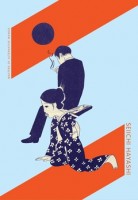 Gold Pollen and Other Stories by Seiichi Hayashi. The first volume in PictureBox’s Masters of Alternative Manga, Gold Pollen and Other Stories collects four of Hayashi’s short manga from the late sixties and early seventies—”Dwelling in Flowers,” “Red Dragonfly,” “Yamanba Lullaby,” and the three chapters from the unfinished “Gold Pollen”—in addition to an autobiographical essay by Hayashi and an essay by the series’ editor Ryan Holmberg. I am particularly grateful for the inclusion of these essays for they reveal some of the semi-autobiographical aspects of Hayashi’s manga that I would have otherwise missed. It is clear that his mother and the concept of what a mother should be influenced him greatly. Each of the manga included in the volume deals with motherhood at least tangentially if not directly. While the manga share some similar characteristics and themes, each is distinctive in both storytelling and art style. Hayashi’s use of color is also rather striking. Gold Pollen and Other Stories is an excellent start to the series; I’m looking forward to future volumes a great deal.
Gold Pollen and Other Stories by Seiichi Hayashi. The first volume in PictureBox’s Masters of Alternative Manga, Gold Pollen and Other Stories collects four of Hayashi’s short manga from the late sixties and early seventies—”Dwelling in Flowers,” “Red Dragonfly,” “Yamanba Lullaby,” and the three chapters from the unfinished “Gold Pollen”—in addition to an autobiographical essay by Hayashi and an essay by the series’ editor Ryan Holmberg. I am particularly grateful for the inclusion of these essays for they reveal some of the semi-autobiographical aspects of Hayashi’s manga that I would have otherwise missed. It is clear that his mother and the concept of what a mother should be influenced him greatly. Each of the manga included in the volume deals with motherhood at least tangentially if not directly. While the manga share some similar characteristics and themes, each is distinctive in both storytelling and art style. Hayashi’s use of color is also rather striking. Gold Pollen and Other Stories is an excellent start to the series; I’m looking forward to future volumes a great deal.
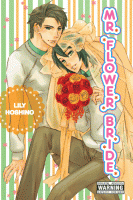 Mr. Flower Bride / Mr. Flower Groom by Lily Hoshino. The powerful Souda family has an unusual marriage custom—in order to prevent disputes over inheritance, the younger sons in the family are partnered with male brides. The basic premise of the two Mr. Flower volumes could have easily been the basis for a comedy manga. But instead, Hoshino plays it straight, honestly addressing the personal challenges and issues that the characters have to deal with in regards to arranged marriage with the additional twist that they both happen to be the same sex. Mr. Flower Bride and Mr. Flower Groom follows two related couples with similar plots—both brides are already in love with their reluctant husbands and both pairs have to navigate jealousy and come to terms with their developing relationships. However, the stories do play out differently. The two Mr. Flower manga end up being rather sweet and even a little lovey-dovey in places, which is not to say that the newlyweds do not have their problems. I enjoyed both volumes, but Mr. Flower Groom has the more interesting gender dynamics of the two.
Mr. Flower Bride / Mr. Flower Groom by Lily Hoshino. The powerful Souda family has an unusual marriage custom—in order to prevent disputes over inheritance, the younger sons in the family are partnered with male brides. The basic premise of the two Mr. Flower volumes could have easily been the basis for a comedy manga. But instead, Hoshino plays it straight, honestly addressing the personal challenges and issues that the characters have to deal with in regards to arranged marriage with the additional twist that they both happen to be the same sex. Mr. Flower Bride and Mr. Flower Groom follows two related couples with similar plots—both brides are already in love with their reluctant husbands and both pairs have to navigate jealousy and come to terms with their developing relationships. However, the stories do play out differently. The two Mr. Flower manga end up being rather sweet and even a little lovey-dovey in places, which is not to say that the newlyweds do not have their problems. I enjoyed both volumes, but Mr. Flower Groom has the more interesting gender dynamics of the two.
 Kaiji: Against All Rules directed by Yūzō Satō. If I had to choose, I think I enjoyed the first Kaiji anime series slightly more, though I liked the second one, as well. The stakes in the first series were incredibly high—the gamblers were literally risking their lives. To some extent this is still true in the second series, but for the most part the large amounts of money involved have become more prominent than life and limb. The ways of cheating, counter-cheating, and general manipulation of the games in the second series also tend to be much more outlandish, convoluted, and unbelievable than in the first. However, it is impressive for how long, and for how many episodes, a single pachinko game can be stretched. By the end of the series I was starting to anticipate some of the major plot twists and developments before they actually happened which unfortunately made the big reveals much less effective. Even so, there were still a few surprises in store and Kaiji remains an incredibly intense and dramatic anime.
Kaiji: Against All Rules directed by Yūzō Satō. If I had to choose, I think I enjoyed the first Kaiji anime series slightly more, though I liked the second one, as well. The stakes in the first series were incredibly high—the gamblers were literally risking their lives. To some extent this is still true in the second series, but for the most part the large amounts of money involved have become more prominent than life and limb. The ways of cheating, counter-cheating, and general manipulation of the games in the second series also tend to be much more outlandish, convoluted, and unbelievable than in the first. However, it is impressive for how long, and for how many episodes, a single pachinko game can be stretched. By the end of the series I was starting to anticipate some of the major plot twists and developments before they actually happened which unfortunately made the big reveals much less effective. Even so, there were still a few surprises in store and Kaiji remains an incredibly intense and dramatic anime.


